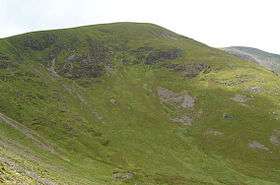Riva
Riva may refer to:
People
Places
In music
Other
See also
Zki & Dobre
HIDDEN ERROR: Usage of "Official_website" is not recognized
Zki & Dobre, known by many aliases, but currently most well known as Chocolate Puma (alternatively as The Good Men and as The Goodmen), are a Dutch house music duo from Haarlem, Netherlands. They comprise Gaston Steenkist ("Dobre") and René ter Horst ("DJ Zki"). They have produced multiple dance hits under various group names since the early 1990s. Their biggest international hits remains "Give It Up in 1993 credited as The Good Men and "Who Do You Love Now?" in 2001 credited to Riva featuring Dannii Minogue. They also founded their own record label Pssst Music.
Career
As the Goodmen, their biggest hit was "Give It Up", a 1993 house music track based upon samba styled percussion and the simple, repeating vocal line of the song title. The percussion for the release was inspired by an earlier recording by Sérgio Mendes.
The song hit #1 on the US Billboard Hot Dance Club Play chart in 1993 and made a brief appearance on the US Billboard Hot 100 chart, peaking at #71. After being re-released in late 1993, it reached #5 in the UK Singles Chart.
Riva (band)
Riva was a pop rock band from Zadar, Croatia, then Yugoslavia, in the late 1980s.
After forming in 1986, the band appeared on Zagrebfest 1988. Their song "Rock Me" won the Eurovision Song Contest 1989 in Switzerland, with a score of 137 points. According to author John Kennedy O'Connor in The Eurovision Song Contest – The Official History it was an unexpected win. The band proved sceptics wrong bringing the first and only victory for Yugoslavia. The contest was organised in Zagreb in 1990. The group members parted ways in 1991.
Lineup
References
External links

Sail
A sail is a catchment device designed to receive and redirect a force upon a generous surface area. Traditionally, the surface was engineered of woven fabric and supported by a mast, whose purpose is to propel a sailing vessel. Sails may be configured in many ways to include traditionally understood maritime purposes, as well as land vehicles and solar collection purposes. The rich encyclopedic history of maritime sails suggests alternative uses of the technology well documented.
History of sails
Archaeological studies of the Cucuteni-Trypillian culture ceramics show use of sailing boats from the sixth millennium onwards. Excavations of the Ubaid period (c. 6000 -4300 BC) in Mesopotamia provides direct evidence of sailing boats. Sails from ancient Egypt are depicted around 3200 BCE, where reed boats sailed upstream against the River Nile's current. Ancient Sumerians used square rigged sailing boats at about the same time, and it is believed they established sea trading routes as far away as the Indus valley. The proto-Austronesian words for sail, lay(r), and other rigging parts date to about 3000 BCE when this group began their Pacific expansion.Greeks and Phoenicians began trading by ship by around 1,200 BCE.

Sail (Lake District)
Sail is a hill in the English Lake District, lying between Derwentwater and Crummock Water.
Topography
The North Western Fells occupy the area between the rivers Derwent and Cocker, a broadly oval swathe of hilly country, elongated on a north-south axis. Two roads cross from east to west, dividing the fells into three convenient groups. The central sector, rising between Whinlatter Pass and Newlands Pass, includes Sail. The highest ground in the North Western Fells is an east-west ridge in this central sector, beginning with Grasmoor above Crummock Water and then gradually descending eastwards over Crag Hill, Sail, Scar Crags and Causey Pike.
Sail is in every sense a satellite of Crag Fell, although having sufficient prominence to be listed as a Hewitt. From the summit of Crag Hill the eastward ridge narrows between opposing walls of crag. This rocky crest is The Scar, the depression being at around 2,425 ft. The roughness decreases as the rounded top of Sail is reached, and the ridge then turns east north east. A further depression at 2,015 ft leads to the summit of Scar Crags. This col is unnamed on maps of the Ordnance Survey, but Alfred Wainwright termed it Sail Pass in his influential Pictorial Guide to the Lakeland Fells

Sail (anatomy)
A sail is a large, flattish protrusion from the back of an animal colinear with the spine. Many extinct species of amphibians and reptiles have very extended neural spines growing from their back vertebrae. These are thought to have supported a sail. Paleontologists have proposed many ways in which the sail could have functioned in life.
Function
Many suggestions have been made for the function of the sail. The consensus amongst modern scholars is that, at least for the pelycosaurs, the sail was used for thermoregulation.
Thermoregulation
The structure may have been used for thermoregulation. The base of the spines have a channel which it is proposed contained a blood vessel supplying abundant blood to the sail. The animal could have used the sail's large surface area to absorb heat from the sun in the morning. As ectotherms they required heat from an external source before their muscles would start to function properly. A predator would thus have an advantage over its slower moving prey. The sail could be used in reverse if the animal was overheating. By standing in the shade, the sail would radiate heat outwards.
Podcasts:

